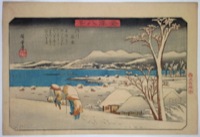Winter landscapes
Approximately 70% of Japan’s landscape is mountainous. In the past when travel into the mountains was difficult there was a large demand and great curiosity by the public to see those remote snow covered landscapes. Publishers and leading artists like Hiroshige and Hokusai responded to that demand by ensuring that every landscape set had at least one snow scene and, often, as in the 100 Views of Edo set, there were as many as seven.
Winter landscapes, because of their minimalist nature appeal to a modern aesthetic and are probably the most popular and expensive landscape prints to collect now. They most often show travellers in a snowy pass but we can also enjoy scenes of Edo (Tokyo) under deep snow. Tokyo’s location on the coast of the Pacific Ocean affords the city mild winters with cool spells. Snowfall does occur annually but it is sporadic and it seldom stays. Perhaps there were heavier falls one or two hundred years ago but more likely artists used snow imagery as a way to both emphasise the season and to transform both landscape and cityscape.
In ukiyo-e a number of techniques were used to suggest snow: areas of image were left blank or block cutters and printers created texture on the paper using gauffrage (blind-printing) in which the block is printed without pigment. This convincingly conveyed snow and is primarily found on prints of the Harunobu period and surimono both of which were printed using thick hosho which is ideal for blind-printing.
White pigment was also used: gofun which was prepared from powdered clam shells [calcium carbonate] or shiro prepared from white lead carbonate. Snowflakes could be cut into the blocks and printed; or gofun or shiro could be splashed from a brush onto the paper, or applied by using a right-angle pipette. It could also be applied by taking it into the mouth and spraying through the lips. Splashed pigment is also commonly used to suggest sprayed water.
The shiro usually oxidises over time so that in some prints it appears to be snowing black snow. This is the result of the print’s exposure to air borne acid pollution. Not all oxidation is unpleasant: it can give a print an attractive patina. Print collectors will have noticed another effect of oxidisation- the shiro was also mixed with red for flesh tones which is why one comes across blackened faces on some prints. Oxidation can be easily reversed by a restorer, and once professionally reversed will be stable.
